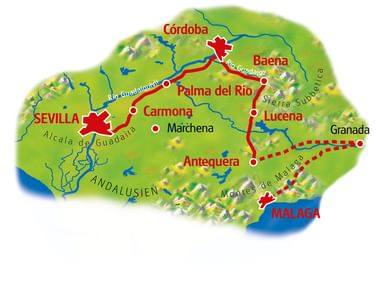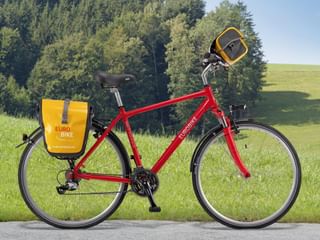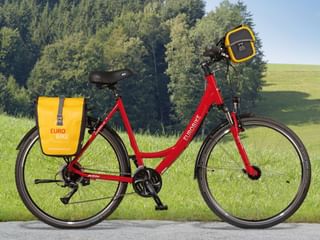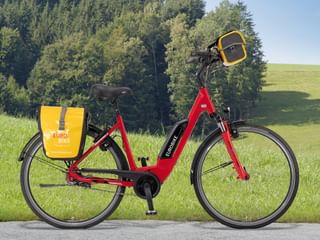High-quality men's touring bike with classic diamond frame
Body size approx. 165 cm - 205 cm

Cycle through Andalusia from Antequera to Seville on this athletic self-guided tour. Ride through olive groves on former railway lines and service roads, covering approximately 45-65 km daily. Explore historic Córdoba with its famous Mezquita, the hilltop town of Baena, and charming Carmona. Follow the Guadalquivir River through fertile valleys and rolling hills. The journey concludes in Seville, home to the world's largest Gothic cathedral and vibrant flamenco culture.
Andalusia, the southern gem of Spain, invites you to a unique adventure filled with bullfights, tapas, fiestas, and the enchanting rhythms of flamenco. This region, nestled at the southernmost tip of Spain, offers a paradise of unexpected wonders. Andalusia paints a captivating picture with its Flamenco dancers in flowing red dresses, hilltop white villages, Moorish palaces, and the resplendent attire of bullfighters in bustling arenas. Here, you'll encounter an exquisite blend of European and Arabic cultures, where scenic beauty harmoniously intertwines with masterful architecture.
Today, Andalusia seamlessly melds modernity with rich traditions. Join us on well-developed routes and tranquil byways through lush hills, verdant river valleys, and the untamed Sierras. You'll have the opportunity to explore Seville and Cordoba, the spiritual epicentres of Moorish Andalusia.
As you wander through narrow streets, vibrant markets, and the historic Real Alcazar and Mezquita, you'll journey through time and be transported to days when Andalusian scholars illuminated the darkness of the European Middle Ages. So, come and savour the flavours of Andalusia: cervezas, tapas, wine, and jamon Iberico. Andalusia eagerly awaits your visit!
Anticipate expansive landscapes, rolling hills, and stunning Spanish coastlines. Discover picturesque towns and immerse yourself in the Moorish influences that permeate the architecture and lifestyle. It's a grand, vast, and captivating experience in every direction. There's no better way to get up close and personal with this impressive region in southern Spain than by bike.
During this nine-day bike tour, you'll swiftly discover how the European and Arabic cultures seamlessly coexist. Almost every day, you'll hop on your bike and immerse yourself in the world of bullfighters, fiestas, and the internationally renowned flamenco scene.
Seville showcases an enchanting fusion of Andalusian art and contemporary architecture, while Cordoba beckons with its awe-inspiring "Forest of a Thousand Pillars" housed within the Mezquita Cathedral. Amidst these cultural treasures, indulge in the pleasures of tapas, sips of fine red wine, and moments of serenity in the peaceful olive groves.
The southernmost region of Spain unveils its authentic beauty when you immerse yourself in it, and what better way to do so than from the saddle of your trusty bike!
Over the course of eight days, journey through this captivating landscape, passing through renowned cities like Malaga, Cordoba, and Seville. With your bike as your companion, you have the freedom to pause wherever your heart desires. Perhaps beneath the shade of ancient olive trees or amidst the labyrinthine streets of the Moorish town of Carmora? The choice is yours to make.
Urban flair in Seville: Modern architecture meets old Andalusian architecture in Seville.
Córdoba and the Mezquita: The second largest Moorish structure in Europe, after the Alhambra, enchants you with numerous details such as the "Forest of a Thousand Pillars".
The cycling stages are alternately flat and hilly with some longer climbs. You ride on bicycle paths (former railway lines) and service roads. Occasionally some road traffic is expected (when entering and exiting the city).

Accommodation in 3*** and 4**** hotels
Prices shown exclude bike hire
Hotel lists are available on request for all holidays
Further information about this cycling holiday.

High-quality men's touring bike with classic diamond frame
Body size approx. 165 cm - 205 cm

High-quality unisex touring bike with comfortable low entry
Body size approx. 148 cm - 190 cm

Sportier, lighter and more precise premium rental bike with a diamond frame
Body size approx. 155 cm - 205 cm

High-quality unisex electric bike with comfortable low entry
Body size approx. 148 cm - 195 cm